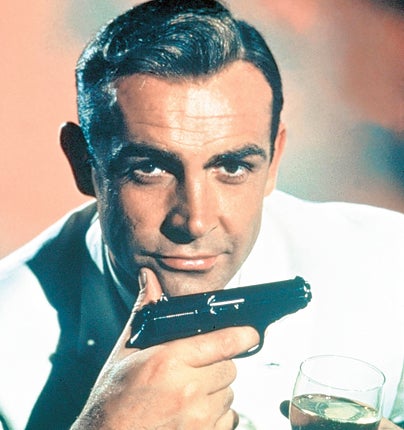John Walsh: I needed a less perfect role model than Bond

Born three years apart (1922 and 1925) and dying one day apart, Arthur Penn and Tony Curtis were crucial figures in the mid-1960s to my generation of baby boomers. At 12 or 13, we were looking for male role models who were nothing to do with the war. Rock guitar heroics hadn't yet pinged on my hero radar. Literary heroes also lay some years off. The tiny TV set was full of cowboys and stolid policemen. We looked for inspiration to the silver screen, specifically the one at the Granada cinema in Clapham Junction.
That's where I encountered James Bond (the Sean Connery version,) but he wasn't much use as a role model. Connery was so remorselessly good at everything, piloting helicopters, drinking martinis, shooting, running, snogging, opening champagne, making ironic remarks. You couldn't imitate or follow that. But then I saw Tony Curtis in The Great Race in 1965, and called off the search for a hero.
The Great Race, a wild slapstick fantasy directed by Blake Edwards, was panned by the critics and is now pretty well forgotten, but I loved it. It paired Curtis and Jack Lemmon for the first time since Some Like It Hot, with Curtis as a daredevil, escapologist racing driver called The Great Leslie competing in the 1908 New York-to-Paris race with his devilish rival Professor Fate (Lemmon).
Curtis was 40, and astoundingly, if self-consciously handsome: when he smiled, starlight twinkled off his dazzling teeth. His character travelled everywhere in a white suit (an early version of the author Tom Wolfe), was gallant with ladies, and always immaculate (he walked unscathed through the world's biggest pie fight); at the end he threw the race in order to declare his love for the suffragette Miss DuBois, played by Natalie Wood in a corset. He wasn't a spy, he didn't shoot anyone, he didn't care for sport or winning, he was cultured and dashing. That did it. At 12, I resolved to be like The Great Leslie. (though I'd have to work on the dental gleam.)
Two years later, it wasn't the violence in Bonnie and Clyde that pinned me to my seat. It was Faye Dunaway's face and Warren Beatty's clothes. In 1967, male fashion was changing, from kipper ties and brass-button blazers to jeans, T-shirts and Californian hippie threads. If you didn't join in with this new uniform of grooviness, you were thought a bit straight, a bit suspect. Which is why, when not gazing longingly at Ms Dunaway's wanton pout, I gazed enviously at Beatty's coolly formal threads. The three-piece tweed suit worn for a bank heist! Ditto the blue corduroy! The collarless white shirt and black waistcoat! The tieless shirt buttoned to the neck, with optional shoulder holster! I loved the violence (St John's ambulance-men patrolled the stalls of the ABC Wimbledon in 1967, waiting for fainters) and the bittersweet emotional arc, but it was the clothes... So I'm in mourning today for an actor and a director who gave us (okay me) images of the hero, the outsider and the lover that stayed in my head for ever, that dealt in the relativity of virtue and vice – and that hinted at how clothes can change your life.
First things first Ed: sort out those adenoids
Ed Miliband has a vast agenda of things to worry about, but I strongly suggest he puts this one near the top: his adenoids. They're in a terrible state. Even when not compounded by a head-cold, they make everything he says sound glutinous, thick and ill. In his maiden speech as Labour leader he said, "We have been give a mandate for change..." which came out as "We have been given a band-aid for change". But why has he got adenoids anyway? In ordinary people, they usually shrink after you're five, and disappear in your teens. It's as though he's got some arrested-development, stuck-in-childhood thingy that won't go away...
Way to a woman's heart? A well ironed shirt, apparently
As my colleague Terence Blacker notes today, a new survey of 3,000 women claims the modern gentleman is no longer expected to open doors for women, pull out chairs for women, or pay for dinner a deux. It's far more important, apparently, to send loving text messages, post things on her Facebook wall, be understanding about pre-menstrual stress, and comforting when she has a hangover. And they say romance is dead. But there are signs that modern girls cling to old-fashioned ideas of etiquette. Most women think it impolite for a man to send a text while on a date, or to mention old girlfriends. You don't say? Showing her pictures of your ex's naked body on his iPhone, with the words, "You can see the attraction, can't you – just look at Gabriella's norks," is probably a no-no as well, though the survey doesn't mention it.
The point of the survey becomes clear at the end when, we're told, three-quarters of women felt it "essential" that a gentleman should wear an ironed shirt every day, half felt that "a true gentleman" should wear cufflinks, 16 per cent like to see a man with a pocket hankie, and five per cent would prefer to see their partner wearing a bowler. Yes, you guessed it, the survey was conducted by a conservative gents' outfitters, namely Austin Reed, always keen to shift a few more cufflinks and bowlers, and discourage the sale of T-shirts. I'm surprised the survey didn't "discover" that 80 per cent of women are desperate for the return of the cravat, the cummerbund and the spat.
j.walsh@independent.co.uk

Join our commenting forum
Join thought-provoking conversations, follow other Independent readers and see their replies